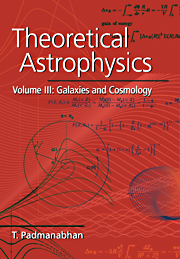Book contents
- Frontmatter
- Contents
- Preface
- 1 Overview: Galaxies and Cosmology
- 2 Galactic Structure and Dynamics
- 3 Friedmann Model of the Universe
- 4 Thermal History of the Universe
- 5 Structure Formation
- 6 Cosmic Microwave Background Radiation
- 7 Formation of Baryonic Structures
- 8 Active Galactic Nuclei
- 9 Intergalactic Medium and Absorption Systems
- 10 Cosmological Observations
- Notes and References
- Index
9 - Intergalactic Medium and Absorption Systems
Published online by Cambridge University Press: 05 June 2012
- Frontmatter
- Contents
- Preface
- 1 Overview: Galaxies and Cosmology
- 2 Galactic Structure and Dynamics
- 3 Friedmann Model of the Universe
- 4 Thermal History of the Universe
- 5 Structure Formation
- 6 Cosmic Microwave Background Radiation
- 7 Formation of Baryonic Structures
- 8 Active Galactic Nuclei
- 9 Intergalactic Medium and Absorption Systems
- 10 Cosmological Observations
- Notes and References
- Index
Summary
Introduction
In this chapter we deal with the physical processes that take place in he diffuse IGM and their signatures in the quasar spectra in the form of hydrogen absorption lines. It uses material developed in several previous chapters, especially Chap. 7.
Gunn–Peterson Effect
We have seen in Chap. 4 that the formation of neutral matter and the decoupling of radiation occurred at z ≃ 103. Because it is unlikely that the formation of structures at lower redshifts could have been 100% efficient, we would expect at least a fraction of the neutral material, especially hydrogen, to remain in the IGM with nearly uniform density. This neutral hydrogen could, in principle, be detected by an examination of the spectrum of a distant source, like a quasar. Neutral hydrogen absorbs Lyman-α photons, which are photons of wavelength 1216 Å that corresponds to the energy difference between the n = 1 and the n = 2 states of the H atom. Because of the cosmological redshift, the photons that are absorbed will have a shorter wavelength at the source and the signature of the absorption will be seen at longer wavelengths at the observer. We expect the spectrum of the quasar to show a dip (known as the Gunn–Peterson effect) at wavelengths on the blue side (shortwards) of the Lyman-α emission line if neutral hydrogen is present between the source and the observer.
Information
- Type
- Chapter
- Information
- Theoretical Astrophysics , pp. 518 - 551Publisher: Cambridge University PressPrint publication year: 2002
